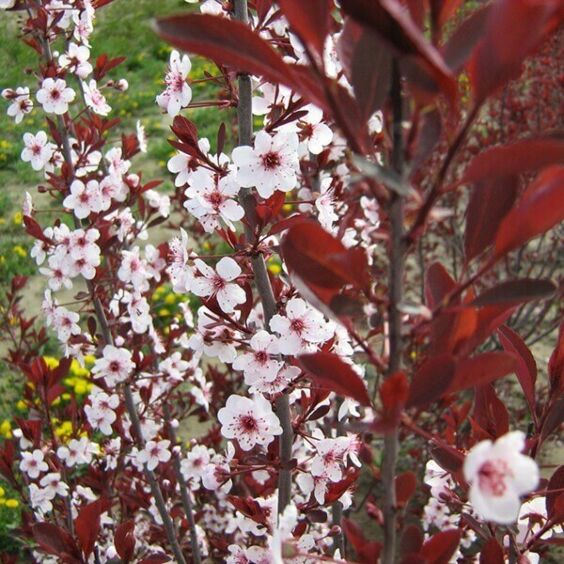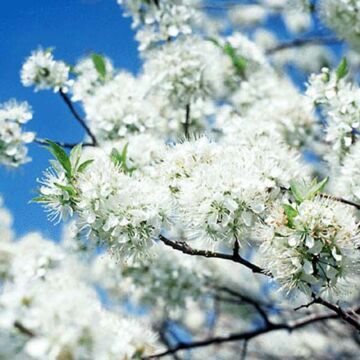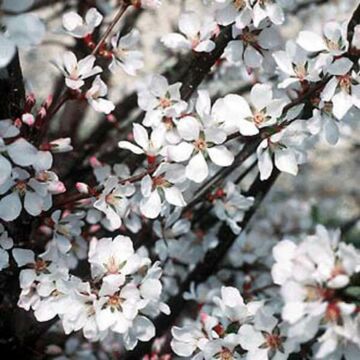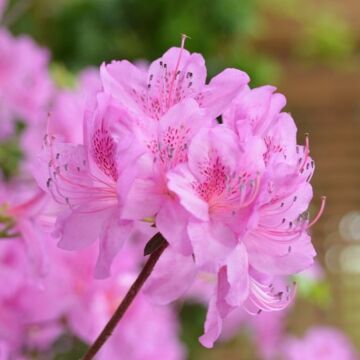Growing zones
See Zone Map >Status: In stock
Please note: #5 containers cannot be shipped to Arizona, California, Idaho, Montana, Nevada, Oregon, Utah, Washington due to size restrictions.
- Sun
Mature Plant Size (H x W): 8-10' x 8-10'
Bloom Season: Spring
- Attracts Bees
- Attracts Birds
- Walnut Toxicity Resistant
- Cut Flower
- Attracts Pollinators
Planting & Care for Purpleleaf Sand Cherry
Preparation
- Can work as a shrub or small tree in the landscape due to its size.
- Should be sheltered from strong winds.
- Evergreen varieties thrive in light shade or partial sun.
- Fragrant flowers turn from white to pink.
- All Prunus plants prosper on any well-drained soil enriched with organic matter.
- Evergreen varieties also thrive on thin, sandy soils.
- Plant in March, May-November.
- Prune in April, July-August.
Opening Plant Material
- Bare Root: Cut open the bundle (top and roots are tied) and separate all the plants. Soak roots in buckets of water until planted. Each plant type will be labeled separately for identification. Keep the roots from full sun since they should never dry out. Keep roots covered. All bare-root plants must be trimmed when planted.
- Containers: Completely saturate all container plants by putting them in a larger water container until bubbling stops. Remove the plant, then dig a hole no deeper than the depth of the container, ensuring it’s wider on the sides by an additional 6” or more.
Planting Bare Root
- Plant bare root in the fall. A good indicator of whether you can still plant is if the ground is still workable. If a hard frost is expected, hold off on planting.
- Dig a hole at least 6" wider and at the same depth as the root mass. The crown or graft of the plant should be slightly higher than ground level where it was grown at the nursery.
- Trim off the broken roots and branches.
- Place fertilizer packets in the hole (if purchased). Do not place other fertilizers in the planting hole. *Use Our Recommended Fertilizer.
- Spread the roots and fill halfway with soil, then water until the soil settles completely, saturating the soil and planting pit.
- Re-adjust the plant and fill the hole with the rest of the soil.
- Backfill the balance of the soil and water well.
Planting Containers
- Slide the plant from the pot by tapping on the bottom of the pot.
- With a shovel or knife, trim the bottom 2" off the root ball for plants in plastic containers.
- Rotate the plant to the proper position. Never lift or move plants by the tops.
Place the root ball in the hole. - Notice where the base of the trunk flares out from the tree. This is called the root flare. This root flare should show when the tree is planted. Add soil under the ball so the root flare is exposed if necessary.
- Place fertilizer packets into the bottom of the hole (if purchased). *Use Our Recommended Fertilizer.
- Backfill the hole with soil, ensuring the top of the root ball is visible and slightly higher than the soil around it.
- Firm the soil around the plant. Water well to settle soil around the root ball.
Pruning - After Planting
- Bare Root: Prune ALL bare root plants to reduce transplant shock and ensure successful planting. Pruning should occur as soon as possible, before or after planting, and with sharp pruning shears.
- Containers: Although it’s not essential after planting, light pruning can improve a Purpleleaf Sand Cherry’s shape. Doing so removes any broken branches from shipping or thins out a heavily branched plant to help in the transplanting process and in the appearance of your new planting.
Pruning - Through-out the Season
- Prune in April, July-August
- Deciduous varieties: No regular pruning is necessary. Cut out crowding shoots from mid to late summer.
- Evergreen varieties: shear laurel hedges in spring and late summer.
Watering - After Planting
- Plants typically take approximately 6 weeks to establish new roots in your soil. During this period, water plants as often as every 2-4 days at the start and at least a minimum of once per week.
- Beyond the 6-week establishment period, water once per week unless rains occur.
- Remember to check soil moisture by sticking your finger into the soil around 3”.
Watering - Through-out the Season
- After the first season, plants should only be watered during extended periods without rain.
- How do you know if your plants need water? The easiest way to tell is to touch the soil around the roots. If it is moist, there is no need to water. If it’s dry, give it a good soak with the hose end (no nozzle), watering the soil only, not the leaves.
- Same as after planting, stick your finger into the soil around 3” to check soil moisture.
Frequently Asked Questions
How does the Purpleleaf Sand Cherry contribute to local wildlife?
The Purple Leaf Sand Cherry is particularly beneficial to local wildlife, serving as a valuable food source and habitat. Its fragrant spring blossoms attract bees and butterflies, crucial for pollination. The small, dark purple fruits it produces in late summer are a favorite among birds and small mammals. Additionally, its dense foliage provides shelter and nesting opportunities for various bird species, enhancing biodiversity in landscapes.
What pruning techniques benefit a Purpleleaf Sand Cherry?
Pruning should be conducted after the spring bloom to ensure your Purpleleaf Sand Cherry maintains a healthy and visually appealing structure. This timing helps preserve the plant’s energy and ensures you don’t accidentally remove the current season’s flowers. Start by removing about a third of the oldest stems to maintain a tighter oval shape. Always prune away any damaged or dead branches or twigs to prevent disease and promote healthier growth. For a more manicured appearance, like an ornamental hedge, you can opt for tighter pruning to get a more distinct shape.
What organic treatments are recommended for a Purpleleaf Sand Cherry?
For managing common issues like fungal infections or pests, organic treatments can be very effective. Neem oil is a versatile organic option that can help control insects and diseases by acting as a repellent, reducing insect feeding, and preventing fungal spore germination. Insecticidal soaps can combat aphids and other soft-bodied insects without harming beneficial insects.
What are some challenges in growing Purpleleaf Sand Cherry in colder climates?
Growing a Purpleleaf Sand Cherry in colder climates can present some challenges, although it’s generally hardy across USDA zones 3 through 8. This plant is adaptable to various weather conditions and can thrive in well-drained soil with ample sunshine. However, it may experience reduced growth and vigor when consistently exposed to colder temperatures. This can result in a smaller stature and decrease the number of blooms produced. Despite its overall resilience, these factors should be considered when cultivating this variant of a Prunus pumila in regions with extended cold weather.
How do variations in soil type affect the Purpleleaf Sand Cherry's health?
Its root system thrives best in loamy, well-draining soil and can struggle in heavy clay or overly sandy soils. Clay soils can lead to waterlogging, which promotes root rot and other fungal diseases, while sandy soils may drain too quickly, depriving the plant of necessary moisture and nutrients. Amending the soil with organic matter can improve its structure, water retention, and nutrient content, creating more favorable conditions for healthy growth.
Elevate Your Garden With McKay Nursery's Homegrown Plants
Embark on a transformative gardening journey with McKay Nursery, a trusted name with over a century of horticultural excellence. Located in the lush landscape of Waterloo, Wisconsin, we specialize in high-quality plants, including the mesmerizing Purpleleaf Sand Cherry, to complete your landscape design.
When you choose McKay Nursery, you're not just buying a plant; you're receiving a full spectrum of support to make your garden flourish. Each plant we nurture benefits from our deep-rooted commitment to quality and can be backed by a one-year warranty to help our customers shop confidently.
Order our Purpleleaf Sand Cherry today! Experience the difference with our robust plants and expert advice—contact us at [email protected] or 920-478-2121 for personalized assistance.
Planting & Handling Help
Download our Planting and Handling Guide below to plan for a successful arrival and install of your plants. Be sure to water all plants as soon as they arrive and every day until you’re ready to plant. Keep any bare root bundles in a shady, cool spot with the roots covered at all times.


Learn More
Watch our videos on handling bare root plants, how your order is prepared for shipment and more.


Plant Sizing
What is the difference between Containers, Grow Bags, Bare Root, and Balled & Burlap (B&B)?
Shipping Times


Our FedEx and local shipping times depend on two factors, one is by the region and the second is the type of product being shipped. For example, small fruits are only shipped in spring, but majority of our perennials are shipped from spring until fall. Keep in mind the dates below act as a general guide. Due to unpredictable weather, staffing, inventory and industry demands these timelines can change. Therefore, we cannot guarantee any of these times.
Shipping Dates by Region*
Northern Cold Region: April 22nd - November 7th
Northern Region: April 15th - November 7th
Middle Region: April 1st - November 7th
Southern Region: March 15th - November 7th
Local Delivery (small radius from Waterloo, WI): April 22nd - November 7th
Shipping Dates by Season*
Spring Shipping: Region Start Date (above) - May
Fall Shipping: September - November
Due to unpredictable weather, these times may vary. Some varieties are exceptions due to heat and plant health reasons. Enter your shipping zip code at the top of this page and be sure to check the shipping information on each product before you add it to your cart. If the product is too large or restricted in your state, you will not be able to checkout with that item in your cart.




